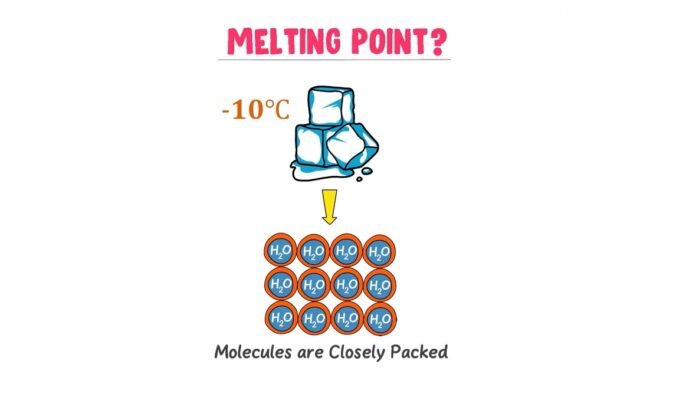The process of changing a substance from one state to another is referred to as a phase change. When a solid is converted into a liquid, it is referred to as melting. This process occurs at a specific temperature known as the melting point.
Understanding Melting with Proper Examples
Melting is the process by which a solid substance is converted into a liquid as a result of an increase in temperature. When a solid substance is heated, its molecules begin to vibrate more vigorously, and the intermolecular forces that keep the molecules together weaken. As a result, the solid gradually transforms into a liquid. This process occurs at a specific temperature known as the melting point.
Melting has several practical applications, including manufacturing, purification, research, and cooking. Understanding the concept of melting is important in various fields, from chemistry and materials science to engineering and food science.
For example :
- In materials science, melting is a critical process used to understand the behavior of materials at different temperatures. The melting point is a fundamental property of a material, and it is often used to identify and classify different materials. Understanding the melting behavior of materials is important in the design and development of new materials with specific properties.
- In the field of engineering, melting is used to create different shapes and forms of materials. For example, metals such as steel and aluminum are melted down and cast into specific shapes to create various products. Melting is also used in welding, where metals are heated to their melting point to join two pieces together.
- In the chemical industry, melting is used to purify substances. Impure substances can be melted down and separated into pure components using fractional melting techniques. Melting is also used in analytical chemistry to determine the purity of a substance. By measuring the melting point of a sample and comparing it to the known melting point of a pure substance, scientists can determine the purity of the sample.
- In the food industry, melting is used in cooking to create a variety of different dishes. Chocolate, for example, needs to be melted down to be used in recipes such as cakes and cookies. Melting cheese is also a critical process used in many dishes, including pizza, lasagna, and grilled cheese sandwiches.
Melting Point
The melting point is the temperature at which a solid substance changes into a liquid. Every substance has its unique melting point, which is determined by the intermolecular forces between its molecules. The melting point of a substance remains constant at a given pressure, regardless of the amount of the substance being melted.
Factors Affecting Melting Point
Several factors can influence the melting point of a substance. These include:
- Pressure: Pressure affects the melting point of a substance. In general, an increase in pressure causes the melting point to increase. This is because pressure has a direct effect on the intermolecular forces between the molecules of the substance. The stronger the intermolecular forces, the higher the melting point.
- Impurities: The presence of impurities in a substance can also influence its melting point. The impurities disrupt the intermolecular forces, causing the melting point to decrease. This is because the impurities weaken the bonds between the molecules, making it easier for them to break apart and transition into a liquid state.
- Atomic or molecular structure: The atomic or molecular structure of a substance also influences its melting point. A substance with a more complex molecular structure will typically have a higher melting point. This is because the more complex the structure, the stronger the intermolecular forces between the molecules.
Significance of Melting
Melting is an important process with several practical applications. Some of these include:
- Manufacturing: Melting is a critical process in manufacturing. Many materials are melted down to be molded into specific shapes or forms. For example, metals such as steel, copper, and aluminum are melted down to make various products such as cars, airplanes, and household appliances.
- Purification: Melting is also used to purify substances. Impure substances can be melted down to separate the pure component from the impurities. This is known as fractional melting, and it is commonly used in the chemical industry to produce pure chemicals.
- Research: Melting is also used in research to determine the purity of substances. Scientists can determine the melting point of a substance and compare it to the known melting point of a pure substance. If the melting points match, then the substance is likely pure. If the melting point is lower, then there are likely impurities in the sample.
- Cooking: Melting is also used in cooking. Many foods, such as chocolate and cheese, need to be melted to be used in recipes. The melting point of these substances is important because if they are heated too much, they can become burnt or lose their desired texture.
Recommended Articles:
Cell Electromotive Force and Internal Resistance
Celsius And Fahrenheit Difference
Central Force: Definition, Equation, Field, Significance, Properties and Variations
Centripetal Acceleration: Definition, Derivation, Understanding, Applications
Centripetal And Centrifugal Force and Its Component
The process of changing a substance from one state to another is referred to as a phase change. When a solid is converted into a liquid, it is referred to as melting. The process ‘Melting’ occurs at a specific temperature known as the melting point. Pressure, impurities and atomic or molecular structure are the three factors which can affect melting. Change State Solid Liquid Melting Point FAQs
What do you understand by phase change?
Explain melting in brief.
Explain the melting point in brief.
Enlist any three factors which affect melting.
